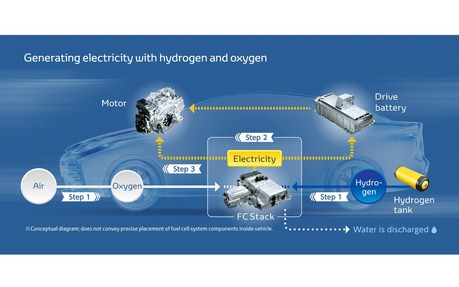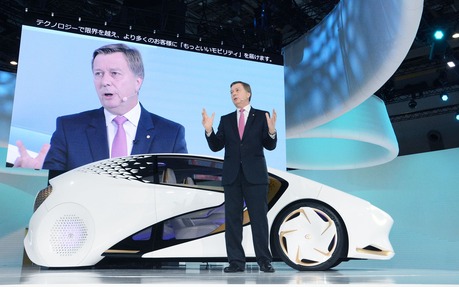Toyota Also Betting on Hydrogen-Powered Vehicles
Manufacturers can’t predict the future, but they all seem to agree that one technology alone won’t replace the internal combustion engine. During our visit to the Tokyo Auto Show, Didier Leroy, Executive Vice-President at Toyota, echoed that very sentiment.
He believes that by 2050, significantly fewer cars will run purely on gasoline. Hybrids and plug-in hybrids will enjoy large shares of the market thanks to their versatility, while battery-powered electric models will be more numerous, particularly in urban areas.
Toyota, like Honda and several other manufacturers, also finds the hydrogen powertrain an interesting option for vehicles that could otherwise be difficult to electrify. Buyers will have a range of choices and their needs will determine the technology that suits them best. Toyota has been working on hydrogen drivetrains since 1992, long before the advent of the Prius.
A vehicle that uses a hydrogen battery is an electric vehicle
Some of you may be wondering just what a hydrogen vehicle is. No, it is not equipped with an engine that burns hydrogen instead of gasoline. In fact, it’s 100% electric, but instead of storing electricity in a battery pack, it is produced by way of a hydrogen chemical reaction in a fuel cell.
It generates an electric current to supply the electric motor, and the hydrogen contained in a reservoir can be refilled in a matter of minutes. Incidentally, this type of vehicle is noticeably lighter than a traditional electric vehicle equipped with a battery pack. Less weight gives you greater range.
In theory, hydrogen vehicles are a very interesting solution. You get a car that is fully electric, produces no emissions and can recover its autonomy in a matter of a few minutes—the time it takes to fill up the tank. But it’s not perfect.

The disadvantages
The big challenge of hydrogen is the distribution network. Have you seen many hydrogen service stations? Probably not. This infrastructure has yet to be developed. We can expect it to hit major urban centres first and to require industry intervention in certain countries. Air Liquide already produces the hydrogen for stations in the northern United States and other companies are also trying to penetrate the market.
Hydrogen’s main detractors point out that large amounts of electricity are required to produce it and that, in many cases, it is made using fossil fuels. To be truly beneficial, hydrogen would have to be made from cleaner sources, like hydroelectricity, wind or solar energy. Consider that, every night, Hydro-Québec generates surpluses that are simply wasted. Why not use these surpluses to produce hydrogen and thus recover lost energy? That’s what a mini wind power station in Japan does, and we had the chance to visit it during our time in the area.
It previously produced electricity with a 23% efficiency rate, but now that the wind power supplies a mini hydrogen power plant, when winds are insufficient, its rate of productivity rises to more than 50%. The hydrogen produced is then sent to various businesses in the port area that use electric fuel-cell forklifts that can’t be plugged in because they’re in constant use. It’s an excellent way to reduce these companies’ emissions.
The advantages
One of the main advantages is practicality. No need to wait for hours for your vehicle to recharge—a fill up of a few minutes will give you back full electric range. This will come in handy when you’re far from a big city or you don’t have access to a charger.
You also get better range because it can store more energy, which is a bonus for those who have a long daily commute. Toyota introduced the Fine-Comfort Ride concept at the Tokyo Auto Show. This vehicle boasts 1000 km of range, thank you very much.
But Toyota isn’t going to ditch the fully electric car just yet. The fuel cell option will complement classic electric vehicles and it promises to be particularly useful for powering models that are difficult to electrify otherwise. People don’t buy cars anymore—and that trend is now global. In North America, 64% of vehicles sold in 2016 were SUVs and pickups.
Because of their size and weight, big vehicles are harder to electrify using batteries. More than 125,000 Ford F-150s were sold last year in Canada. It would be unthinkable to electrify these mastodons and preserve their primary qualities at an affordable price. They use so much energy that their batteries would be heavier than their payload capacity. That’s why hydrogen fuel cells make much more sense for bigger vehicles. And making big vehicles emission-free also has a greater environmental impact than doing the same to smaller cars.
Not just for cars
The same technology can be applied to many types of recreational vehicles, such as leisure boats. Electrifying a pleasure craft makes a lot more sense with fuel cell technology than with a battery pack. On a nice day at the cottage, you want to actually use your boat, not leave it plugged in for hours to recharge the batteries. Ditto for transport: Toyota is preparing the Sora, a bus that uses this technology. It can accommodate 79 passengers and will be used, among other things, to transport visitors at the upcoming 2020 Tokyo Olympic Games.
Basically, hydrogen vehicles will add to the choices already offered, which will make it increasingly complicated to choose your ideal vehicle. Just wait until autonomous driving technology is added to the equation! You’ll need to read every article on The Car Guide to get your bearings.
